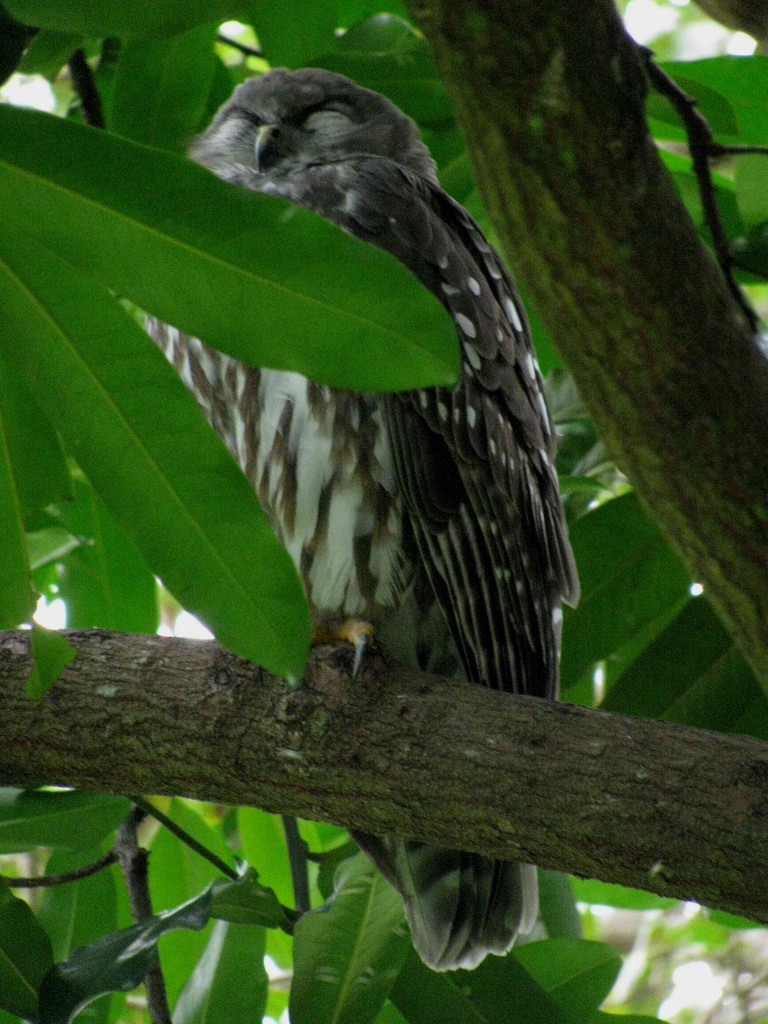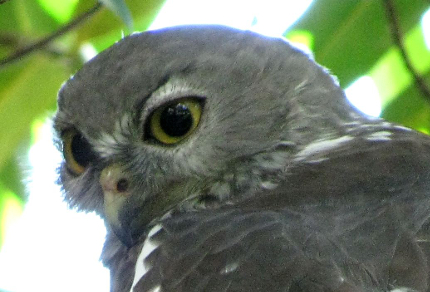In mid-afternoon, weary of the unpacking and cleaning that always accompanies the end of a camping excursion, I cycled the Ross River Parkway to Townsville’s Palmetum Park, hoping to locate the rufous and barking owls Janis and I spotted there last week. Cloud blanketed the sky, spitting drizzle onto me as I rode and creating leaden lighting conditions not at all conducive to identifying birds perched in the tops of tall trees. The distinctive silhouettes of rainbow bee-eaters flew again and again to the river’s surface, splashing there for a moment before returning to perches in a riverside paperbark. The bee-eaters may have been hunting surface insects or simply enjoying a bath.

Barking Owl Asleep (© Magi Nams)
Within the Palmetum, I dipped on the rufous owls (in twitcher lingo, to ‘dip’ is to not see what you came to find), but did find a roosting barking owl in a densely-foliaged tree near the pond. Unlike last Monday, when two barking owls glared at Janis and me out of brilliant yellow eyes, this owl was asleep. It had pale eyelids pulled over its eyes, creating a rather ghostly image. Like all owls, barking owls possess three eyelids, an upper lid that moves down over their eyes when they blink, a lower lid that slides up over their eyes when they sleep, and a nictitating membrane that sweeps diagonally across their eyes to clean and protect them.1
This owl had chosen to roost near water, as barking owls typically do, such a site offering a clearing in which the owl could hunt come nightfall.2 Barking owls are medium-sized owls that inhabit open woodlands and forest edges where large trees provide hollows useful both for nests and for resting places of prey species such as possums, gliders, and parrots.2 Barking owls locate their prey from a perch or in the air, and hunt insects, bats, birds, and terrestrial and arboreal (tree-dwelling) mammals.2,3 Once common throughout Australia with the exception of the desert regions in the centre of the continent, barking owls have decreased dramatically in number in southern Australia. They are, however, still common in northern Australia,3 for which I was thankful as I quietly stepped beneath the branches of the roost tree and stared up at the sleeping owl.
Birding is usually an identification puzzle with the pieces hopping, flying, and squawking, or staring right at you, checking you out. Observing this hidden, sleeping owl seemed almost clandestine.

Barking Owl (© Janis Nams)
Today’s birds: masked lapwings, magpie-larks, rainbow lorikeets, Australian magpies, mynas, straw-necked ibises, white-bellied cuckoo-shrikes, black-faced cuckoo-shrike, little egret, spangled drongo, welcome swallows, brown honeyeaters, peaceful doves, Australian white ibises, rainbow bee-eaters, sacred kingfisher, wandering whistling ducks, figbirds, yellow honeyeater, Pacific black ducks, little black cormorants, intermediate egrets, magpie geese, little pied cormorant, anhinga, comb-crested jacanas, white-throated honeyeater, barking owl, great egret, great bowerbird, forest kingfisher.
References:
1. Bird Observers Club of Australia. Owl Program, A resource kit for environmental educators. Accessed 14-Jul-2010. http://www.birdobservers.org.au/education/pdfs/owl%20kit.pdf
2. Birds Australia. Birds in Backyards: Barking Owl. 2010. Updated 22-Feb-2010. Accessed 14-Jul-2010. http://birdsinbackyards.net/species/Ninox-connivens
3. New South Wales Threatened Species Website. Threatened Species: Species, populations & ecological communities of NSW. Barking Owl – profile. Updated 01-Sep-2005. Accessed 14-Jul-2010. http://www.threatenedspecies.environment.nsw.gov.au/tsprofile/index.aspx


